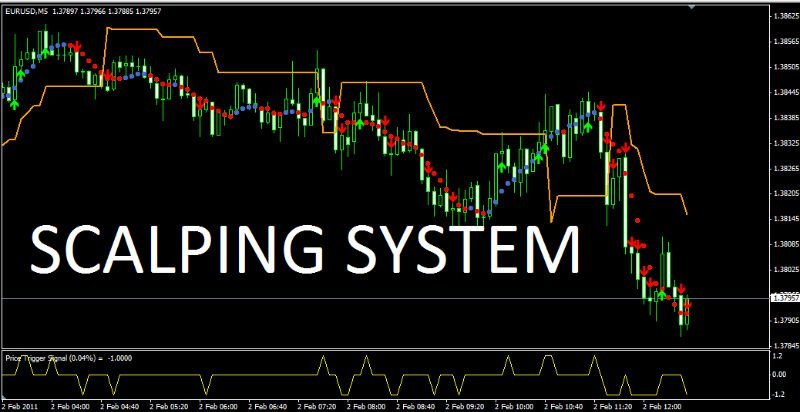
Scalping is a type of trading in which a trader specializes in making money on small price fluctuations, as a rule, they occur immediately after the trader entered the auction and the trades began to make a profit. To do this, a trader needs to have a good command of a strict exit strategy, since one big loss compensates for all those small earnings on which the trader earns when scalping. If the trader has the right tools, such as real-time signals, a broker with direct access, endurance that allows you to place many trades, then this strategy – scalping strategy – will be successful.
The scalping strategy is based on the assumption
that the price of most securities will complete the first stage of fluctuation (the price will fluctuate in the desired direction for a fairly short time, but where it will move next is not clear). The price of some securities will stop growing, the price of others will continue to move up. A trader using a scalping strategy strives for the smallest amounts of profit, but will not allow them to slip away. This approach is contrasted with the opposite mindset, which can be described as “increase profits as much as possible”, where every effort is made to optimize the positive results of trading, increasing the amount of expected profits, while at the same time pushing others away, forcing them to incur losses.
Scalping achieves a certain result due to the fact that the number of earners increases due to the amount of earnings. It is not unusual for a trader to earn only half or even less than what he would have earned with another strategy for quite a long time. But on the other hand, the total amount of his earnings will exceed his costs. A successful trader using the scalping strategy will have a significantly higher percentage of profitable trades than trades as a result of which he will incur losses, but the amount of his profit will either slightly exceed or even equal to the amount of losses incurred by him in trading.
The main advantages of scalping:
• Less risk – Being in the market for a short time reduces the likelihood that events will go unfavorably.
• It’s easier to get minor fluctuations – A larger imbalance in supply and demand is needed in order to provide larger price fluctuations. For a security, a price fluctuation of 10 cents will occur faster and easier than that of $1.
• Smaller swings occur more often than large ones – Even with a relatively calm market situation, there are many small fluctuations that a trader using scalping strategies can use to make a profit.
Scalping can be used as the main or as an additional strategy in trading.
Basic Strategy
A trader who has chosen scalping as his main strategy will make a certain number of trades per day, usually a significant amount, from five or 10 to hundreds. A trader who uses scalping is likely to use a one-minute chart, as the time frame there is small, and it is important for the trader to see the details, since they are the ones that most convey the situation in real time. The Nasdaq Level II, TotalView and/or Times and Sales betting system are quite important tools for this type of trading. Automatic immediate execution of orders is vital for the trader, so a broker with direct access is what such a trader will prefer.
Additional Options Scalping Strategy
A trader working with a different time frame can use scalping as an additional approach, scalping can be used in several ways. The most obvious way would be to use it when the market is volatile, or closed in a narrow spectrum. Where there are no trends with longer time frames, moving to shorter time frames can reveal visible trends that can be exploited. This can lead the trader to scalping.
Another way is to add scalping to trades that are longer in terms of time, through the so-called “umbrella” approach. This approach will allow the trader to improve his earnings and maximize profits.
Bidding with an umbrella is carried out in the following way:
• The trader sets a position for trading in a longer time period.
• As the main trading process develops, the trader determines new settings for a shorter time period, in the direction of the main trading process, entering and exiting trading according to the principles of scalping.
Almost any trading system based on settings of a certain type can be used for scalping. In this respect, scalping can be considered as a kind of risk management method. Basically, any trades can be turned into scalping, with a risk/reward ratio of 1:1, which means that the profit margin is equal to the stop size dictated by the setup. If, for example, a trader enters his scalping position at $20, with an initial stop at $19.90, then the risk will be 10 cents. That is, the risk/reward ratio is 1:1, to be achieved at an amount of $20.10.
Scalping trading can be performed on both long and short time periods. It can be performed in single throws or in a spectrum. Many traditional graphs, such as cups and pens, or triangles, can be used for scalping. The same can be said about technical indicators if the trader makes a decision based on them.
Three types of scalping:
- The first type Scalping can be attributed to “market creation”, when a scalper tries to capitalize on the spread while betting on the offer of a particular security. Obviously, this strategy can only be successful if the trader trades in real estate, where significant trading volumes are involved without real changes in price. This type of scalping is quite complicated, as the trader must compete with market markers for a share in each bet and offer. Also, the profit is so small that any movement on the exchange in the direction opposite to the trader’s position guarantees losses that will surely exceed expectations for the amount of profit.
The other two styles are based on a more traditional approach and require a flexible exchange where prices change very quickly. To use these two styles, you also need a reasonable strategy and methods for reading displacements.
- The second type of scalping is carried out by acquiring a huge number of shares, which are sold with a slight fluctuation in price. A trader of this type will enter trading on the positions of several thousand shares and wait for a small fluctuation, which is often measured in cents. This approach requires a highly liquid asset or commodity to be able to easily enter and exit 3,000 to 10,000 shares.
- The third type of scalping is closest to traditional trading methods. The trader enters the number of shares of any setting or signal from his own system, and closes the position as soon as the first exit signal is generated, the risk/reward ratio is greater than 1:!, calculated in the manner described earlier.
Results
Scalping can be quite profitable for traders who decide to use it as a primary strategy, or even for those who use it as a supplement to other types of trading. Compliance with the exit rules is the basic rule that must be followed in order to earn little by little, accumulating a fairly solid capital. The main attributes that make this strategy so popular among all types of traders are a slight openness to the market and the frequency of small movements.
Tagged with: 60 Seconds Option Strategy • Binary Options Strategy


